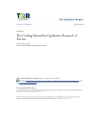
However, despite having apparently attained something of the status of orthodoxy, saturation is defined within the literature in varying ways-or is sometimes undefined-and raises a number of problematic conceptual and methodological issues (Dey 1999 Bowen 2008 O’Reilly and Parker 2013). 2011), or an ‘edict’ (Morse 1995), of qualitative research, and it features in a number of generic quality criteria for qualitative methods (Leininger 1994 Morse et al. 60) refer to it as having become ‘the gold standard by which purposive sample sizes are determined in health science research.’ A number of authors refer to saturation as a ‘rule’ (Denny 2009 Sparkes et al. 587) notes that saturation is ‘the most frequently touted guarantee of qualitative rigor offered by authors’ and Guest et al. 1408) claim categorically that ‘failure to reach saturation has an impact on the quality of the research conducted’ 2 Morse ( 2015: p. Indeed, saturation is often proposed as an essential methodological element within such work. 1 Its origins lie in grounded theory (Glaser and Strauss 1967), but in one form or another it now commands acceptance across a range of approaches to qualitative research. In broad terms, saturation is used in qualitative research as a criterion for discontinuing data collection and/or analysis. We conclude that saturation should be operationalized in a way that is consistent with the research question(s), and the theoretical position and analytic framework adopted, but also that there should be some limit to its scope, so as not to risk saturation losing its coherence and potency if its conceptualization and uses are stretched too widely. In examining these issues, we highlight the uncertain logic underlying saturation-as essentially a predictive statement about the unobserved based on the observed, a judgement that, we argue, results in equivocation, and may in part explain the confusion surrounding its use. We explore the purposes saturation might serve in relation to these different approaches, and the implications for how and when saturation will be sought. We identify four distinct approaches to saturation, which differ in terms of the extent to which an inductive or a deductive logic is adopted, and the relative emphasis on data collection, data analysis, and theorizing. In this paper, we look to clarify the nature, purposes and uses of saturation, and in doing so add to theoretical debate on the role of saturation across different methodologies. However, there appears to be uncertainty as to how saturation should be conceptualized, and inconsistencies in its use. It is commonly taken to indicate that, on the basis of the data that have been collected or analysed hitherto, further data collection and/or analysis are unnecessary.

Saturation has attained widespread acceptance as a methodological principle in qualitative research.


 0 kommentar(er)
0 kommentar(er)
